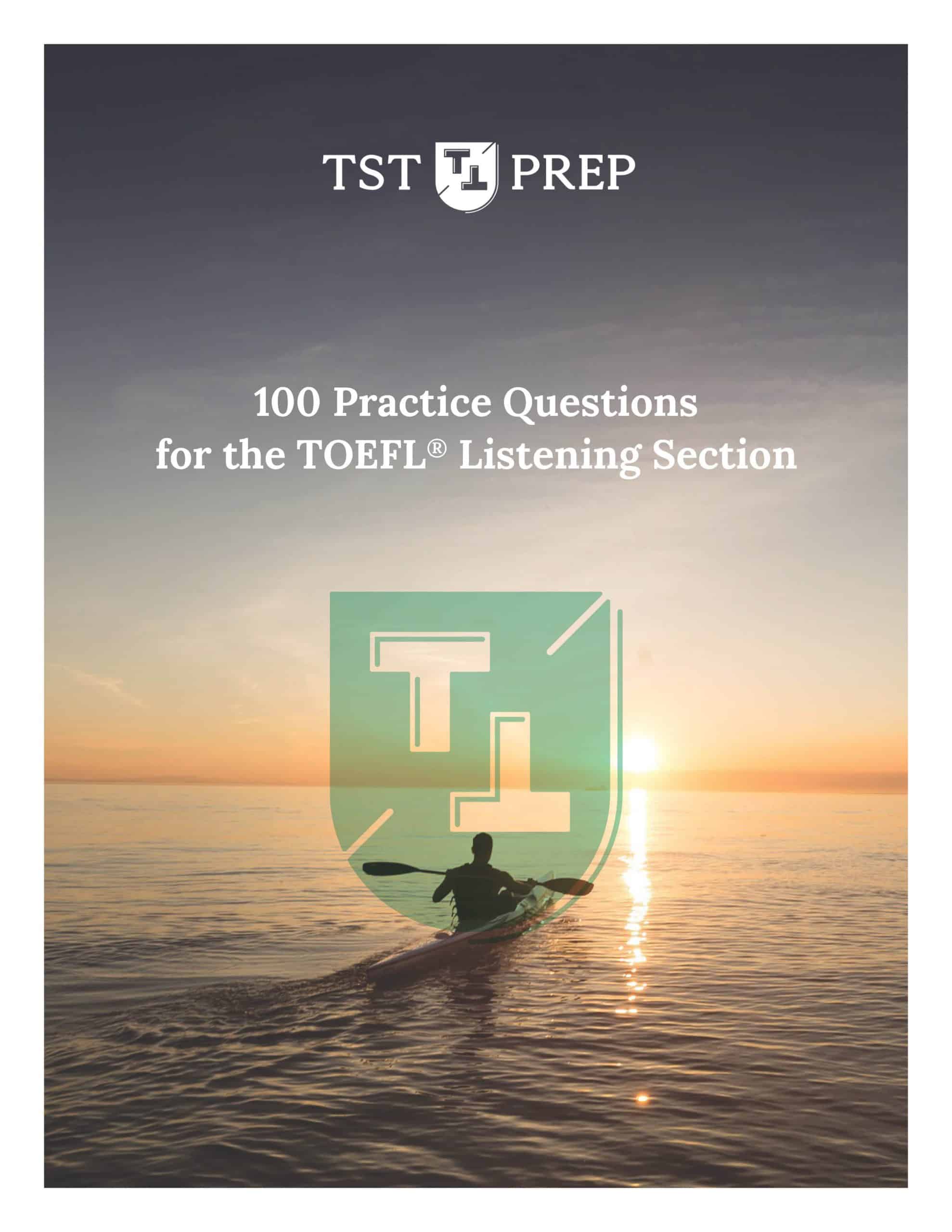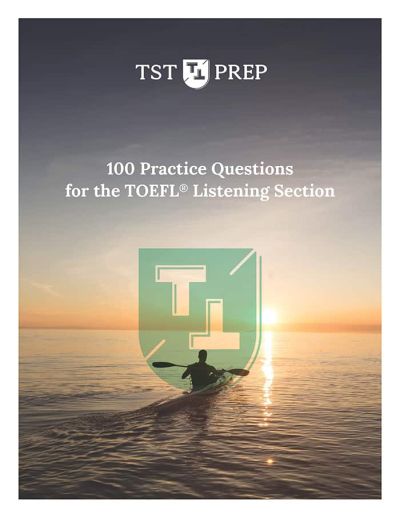First off, if you need any practice you can download our Listening practice for the TOEFL
But if you’re looking for some help on the TOEFL Listening section, whether you’re new to the TOEFL or a TOEFL veteran, I’ve got good news:
You’re in the right place!
These 10 Awesome TOEFL Listening Tips are just what you need to boost your confidence and improve your test-taking skills, whether you are just starting out or you’re having trouble improving your score.
How do I practice the TOEFL Listening?
- Tip #1 - Create a TOEFL Listening study schedule
- Tip #2 - Make your eyes your enemy
- Tip #3 - Become a notetaking pro
- Tip #4 - Memorize the question types
- Tip #5 - Understand the passage structure like a professor
- Tip #6 - Focus on vocabulary less, story more
- Tip #7 - Be an active listener
- Tip #8 - Think like a North American teacher
- Tip #9 - Track your study progress
- Tip #10 - Don't panic
We are not like other TOEFL Prep sites.
We will focus both on what you need to do to improve your TOEFL Listening score and how to do it.
Let’s jump right in!
Tip #1: Create a TOEFL Listening study schedule
- Monday, 9:00 – 10:00 am- TST Prep’s Test #13 Listening section.
- Tuesday, 9:00 – 10:00 am – Review yesterday’s answers. Identify incorrect choices and why I got them wrong.
- Wednesday, 9:00 – 10:00 am- Transcribe one passage from TST Prep test #13. Identify 5 words, phrases, or sentences that I have trouble understanding. Cross-reference with Youglish to check other examples. Record my own pronunciation.
- Thursday, 9:00 – 10:00 am- Practice 20 of TST Prep’s 500 TOEFL Listening practice questions.
- Friday, 9:00 – 10:00 am- Review yesterday’s answers. If there is time, do transcription practice for 3-5x of the more difficult passages.
- Saturday, 9:00 – 10:00 am- Practice 20 of TST Prep’s 500 TOEFL Listening practice questions. Review answers.
- Sunday – RELAX! Day off
- daily errands
- grocery lists
- appointment schedules
Every Sunday, set aside ten minutes to create your weekly schedule. Write down what you plan to study and when you plan to do it. Soon after, you will notice your listening skills grow.
Tip #2: Make your eyes your enemy
Your eyes distract your ears.
Think about when you are having a conversation with someone and there is a TV right behind their head. Your eyes can’t help but notice the screen and you soon realize that you haven’t been listening.
Listening on the TOEFL is even harder than it is in real life.
When talking to someone in real life, we can focus on hand gestures, facial expressions, and body language to give us clues as to what someone is talking about or what emotions they are trying to express.

However, on the TOEFL exam, you can only rely on the voices coming through to your ears. You need to work to diminish your attention to the other four sentences and focus as much attention as possible to the passages.
The problem is that you still can’t just close your eyes as some other sites recommend. You have to take notes and look at the prompts on your screen.
Keep your focus on your computer and workspace.
When sitting for the exam, you’ll be in a room full of other test-takers. Distraction will abound. But remember…
Don’t let your eyes wander.
Tip #3: Become a note-taking pro
This is one TOEFL Listening tip most students know.
If you’re anything like my past pupils, you probably don’t want to take notes.
In the end, it’s your choice, but I strongly recommend that you do.
Here’s why.
Detail questions are the most common type of question in the TOEFL Listening section. They are nearly impossible to answer without notes.
Think about it.
They ask you about a specific detail within a five-minute lecture. Believe it or not, a five-minute lecture packs a lot of content. It’s about the same length as a 700-word essay.
Even if you already take notes, it’s important for you to learn how to take notes efficiently and effectively.
Proper note taking for the TOEFL Listening is a long conversation.
So long, in fact, that we have a whole article about Taking Notes for the TOEFL Listening if you want to learn more.
Tip #4: Memorize the question types
Although the reading and listening sections are similar, the question types in the listening section are slightly different. The types of questions you may encounter include gist-content, gist-purpose, detail, organization, function, attitude, and inference.
You may sometimes see these questions called by a different name, but at the end of the day, they’re all the same.
Take a look at this chart to get a better idea of how to identify each question type.
The Listening Section Question Types |
|||
|---|---|---|---|
| Question Type | Frequency (per section) |
Question Value | Question Phrasing |
| 1. gist - content | 6 | 1 | "What is the topic of the discussion?" "What is the professor mainly discussing?" |
| 2. gist - purpose | 3-5 | 1 | "Why does the student visit the professor?" "Why does the professor mention...?" |
| 3. detail | 10-12 | 1-2 | "What is stated in the passage about..." "According to the speaker..." |
| 4. understanding the speaker's attitude | 3-5 | 1 | "What is the professor's oppinion of...?" "What can be inferred about the student?" |
| 5. understanding the function | 3-4 | 1 | "What doest the speaker mean when he says..." "Why does the professor say this..." |
| 6. making inferences | 5-6 | 1 | "What can be inferred about...?" "What does the speaker imply about..?" |
| 7. understanding organization | 4 | 1-3 | "How does the professor organize the information about..." |
However, memorizing this chart won’t help you all that much.
While it’s important to know the different question types, it’s even more important for you to know how to answer each type.
If you’re the kind of person who likes to do it all on your own, you can also download our 100 TOEFL Listening Practice questions. Reading about these question types can help, but it’s even more powerful if you experience these questions on your own.
Download your free copy of 100 TOEFL Listening practice questions and gain first-hand knowledge of these TOEFL Listening question types.
Tip #5: Understand the passage structure like a professor
- First, a problem is presented by the student.
- Next, the campus worker offers a solution.
- Lastly, the student or campus worker typically describes the steps needed to take to solve the problem. Sometimes, this is disguised in the form of requirements of an assignment.
- Cause and Effect
- Historical Narrative
- Problem and Solution
- Sequence of Steps
- Compare and Contrast
- Category with Specific Examples
- Gather all of the ingredients.
- Next, mix the ingredients together.
The Process of Aging
As human beings grow older, they go through different phases or stages of life. It is helpful to understand aging in the context of these phases. A life course is the period from birth to death, including a sequence of predictable life events such as physical maturation. Each phase comes with different responsibilities and expectations, which of course vary by individual and culture. Children love to play and learn, looking forward to becoming preteens. As preteens begin to test their independence, they are eager to become teenagers.
Teenagers anticipate the promises and challenges of adulthood. Adults become focused on creating families, building careers, and experiencing the world as an independent person. Finally, many adults look forward to old age as a wonderful time to enjoy life without as much pressure from work and family life. In old age, grandparenthood can provide many of the joys of parenthood without all the hard work that parenthood entails. And as work responsibilities abate, old age may be a time to explore hobbies and activities that there was no time for earlier in life. But for other people, old age is not a phase looked forward to. Some people fear old age and do anything to “avoid” it, seeking medical and cosmetic fixes for the natural effects of age. These differing views on the life course are the result of the cultural values and norms into which people are socialized.
This lecture is organized based on the “sequence of steps” structure. The professor introduces the lecture first by mentioning that life happens in phases, and then says it is important to “understand aging in the context of these phases.”
1. Why does the professor talk about “the stages of life?”
- To contrast the old age lifestyle with the teenage years.
- To differentiate between the behavior and goals of most people at different ages.
- To provide some context as to why many people fear old age.
- To contrast old age with adulthood and emphasize why many look forward to old age.
- A is incorrect because it suggests that the professor is comparing and contrasting ideas in the lecture. A does not tell us why the professor discusses all of the stages of life.
- C is incorrect because it is a specific detail from one stage of life, whereas the question is directed towards all the stages of life.
- D is incorrect because similarly to A, it does not have to do with the sequence of phases, but rather suggests that the professor is comparing and contrasting specific stages.
- Thus, B is correct because the professor describes each stage of life in order to help the students understand aging better. By describing each stage, the professor is differentiating the stages.
Understanding the structure of the passage will help you predict important information and eliminate off-topic question choices.
Tip #6: Focus on vocabulary less, story more
- The main idea of the topic
- How the professor illustrates, expands on, or explains the main idea
Focusing on specific, lonely vocabulary words will not improve your TOEFL Listening results. Identifying the main idea and the most important details about the main idea will provide you with the information you need to answer more questions correctly.
Pioneer 10 flew past Jupiter in 1973, after which it sped outward toward the limits of the solar system. Pioneer 11 undertook a more ambitious program, using the gravity of Jupiter to aim for Saturn, which it reached in 1979. The twin Voyager spacecraft launched the next wave of outer planet exploration in 1977. Voyagers 1 and 2 each carried 11 scientific instruments, including cameras and spectrometers, as well as devices to measure the characteristics of planetary magnetospheres. Since they kept going outward after their planetary encounters, these are now the most distant spacecraft ever launched by humanity.
This particular excerpt is not dense in terms of new vocabulary, but do you know what spectrometers are or planetary magnetospheres?
I don’t even know what they mean!
Some students hear big words they don’t understand, freak out, and lose focus.
Remember that the TOEFL Listening section is comprised of a variety of question types. Although detail questions are the most common (and even then they don’t ask you what a word means), all of the other questions aren’t necessarily concerned with small details. In fact, they look more like this:
“What is the lecture mainly about?”
“Why does the professor say this?”
“What is the professor implying?”
This is why focusing on specific vocabulary words won’t help you get the score you need.
Tip #7: Be an active listener
Academic lectures in the TOEFL Listening are tough because, well, they’re boring.
I mean, really boring.
When something is boring, no matter what language, it can be difficult to follow the details and comprehend the overall message.
This is exactly why it’s important to actively listen during lectures.
What is active listening?
One definition of active listening is that it requires feedback from the listener. When you are having a conversation with someone, you naturally listen in an active manner because you need to respond.

- Passive listening – Trying to understand every detail
- Active listening – Trying to understand enough to respond
Tip #8: Think like a North American teacher
- “Why was this information given?”
- “Why is this detail here?”
- “What does the teacher want me to know?”
Teachers speak with purpose, and the intention is to help students understand new and important information.
- “Why was this information given?”
- “Why is this detail here?”
- “What does the teacher want me to know?”
Teachers speak with purpose, and the intention is to help students understand new and important information.
- “Is this going to be on the test?”
- “Will there be a question about this detail?”
Tip #9: Track your study progress
- Write that down along with the date.
- Continue to do the same with different passages, while also reflecting on what you have learned.
- Take the same tests again, perhaps two weeks later. Compare your score and reflect on what you have learned.
- Celebrate! You have improved
Tip #10: Don’t panic
As test day approaches, nerves will creep into your psyche.
It’s natural.
There is no way to avoid feeling nervous, so the first step is to accept that you will be a bit scared when you take the test.
And that’s great.
Fear is a good indicator that you are doing something meaningful.
- Get a good night’s sleep
- Take deep breaths
- Stretch out any tension or anxiety with some yoga poses
Conclusion
Did we miss anything? (or just want to say thanks!)
Let us know in the comments section below.
Don’t hesitate to reach out and let us know if you have any questions at contact@tstprep.com
Happy studies!










29 Comments
Marina
This tips are really good! They’ ve helped me a lot.
thanks very much!
Josh
Thanks for the comment Marina! Much appreciated 🙂
Don’t hesitate to let us know if you have any other questions!
Md Mahmud Hasan
Thank you Josh for giving such details and useful tips for listening . You provide here some unique tips which are really awesome.
Josh
Thanks for noticing! It took a lot of work so I appreciate you noticing 🙂
Vivian M Rodriguez
Phew! That was a lot of useful information.
Very precise and concise.
I also follow your videos on YouTube. They are quite interesting.
A big thanks.
Josh
Hi Vivian and thanks for taking the time to leave a comment, and such a nice one! Happy to help 🙂
Bosire Anyona
What a lesson! Thanks alot JOSH! I have followed and understood the flow of the content. Simple and clear just like a session in class.
Josh
Thank you! I appreciate it 🙂
Ana Karenina Sanchéz Villalobos
Thank you very much for this tips. They have help me a lot. I’ll put them in practice.
Josh
Good to hear and happy to help Ana!
Shakiba
Josh you’re the best, I’ve seen all your YouTube videos.
You’re so funny and your tips are just amazing. My test is in a month (I hope Corona virus gives me more days though). So thank you SO MUCH. Oh and your writing template is a life savor, love you 😡
Josh
Thank you so much for your kind words! Stay safe out there. Hopefully, this all passes soon 🙂
Keren
Thank you so much for this help Sir Josh
Be blessed
Josh
Thanks, Keren! Much appreciated 🙂
Mahbob
Thank you so much for the tips Josh, appreciated. Will be glad if you have such tip to improve reading of TOEFL.
Josh
Hi Mahbob and thanks for commenting! You can always check out our Ten Awesome TOEFL Reading Tips – https://tstprep.com/ten-awesome-toefl-reading-tips/
Carla E.
Thank you all so much for the tips!!!
Josh
Thank you for the support Carla 🙂
Ali
thank appreciate tst prep team. my major problem in this part is getting lost sometimes and i don’t hear some details when i face questions what is solution?
Josh
Hi Ali and thank you for your question. This is a pretty general question so it is hard for me to give any helpful advice. When you have a problem try to make it specific. For example, maybe you have trouble answering vocabulary questions in the TOEFL Reading. Once you make it specific, try to come up with some solutions to your problem or ask a teacher for some guidance.
This is the best way to overcome any TOEFL-related challenge. I hope that helps!
Aaliyah
Josh MacPherson…first of all, I congratulate you on being such a wonderful teacher. You definitely know your subject very well. I can’t thank you enough for providing such amazing content. It is lucid, specific, and well structured. Your videos clear major doubts and above all crashes” TOEFL Phobia”. It gives a head start to a student and then prepares him/her in a planned manner for the exam. You perfectly fit into one of the quotes, “The teacher who is indeed wise does not bid you to enter the house of his wisdom but rather leads you to the threshold of your mind… (Khalil Gibran).
Josh
Wow, thank you so much for leaving such a kind and considerate comment. It’s rare to read something so nice. Thank you for taking the time to write that. It really means a lot. However, you did all the work! You should congratulate yourself on working so hard and learning about all this TOEFL stuff. It’s not a very exciting topic ;).
Alaa
WOW, what great content. They were great tips honestly. Thanks from heart, I really appreciate your great work and I really benefited from them. Thanks a lot, teacher you really deserve a big clap.
Josh
Thank you so much for the comment, Alaa. Let me know if there is any other way I can help.
Cijie Zhang
Thanks for your tips, especially the “Be an active listener”. But I also have some problems of “Understand the passage structure like a professor”, I don’t know how to identify the structure at once, and how to deal with each structure (the same problem also in answer type, I don’t know how to answer each type). Do you have any further suggestions?
Finally, thanks for your help with the articles and videos.
Josh
Hi there and thank you for your questions. I do give advice on all of the issues you mentioned, but it is a bit difficult to explain in a comment, which is why I created the TOEFL Score Builder Course with videos explaining all of these ideas. I will leave a link here to it – https://tstprep.com/store/toefl-score-builder-program/
Ahmed
very good
Josh
Thank you for commenting!
Josh
Thank you for your feedback!